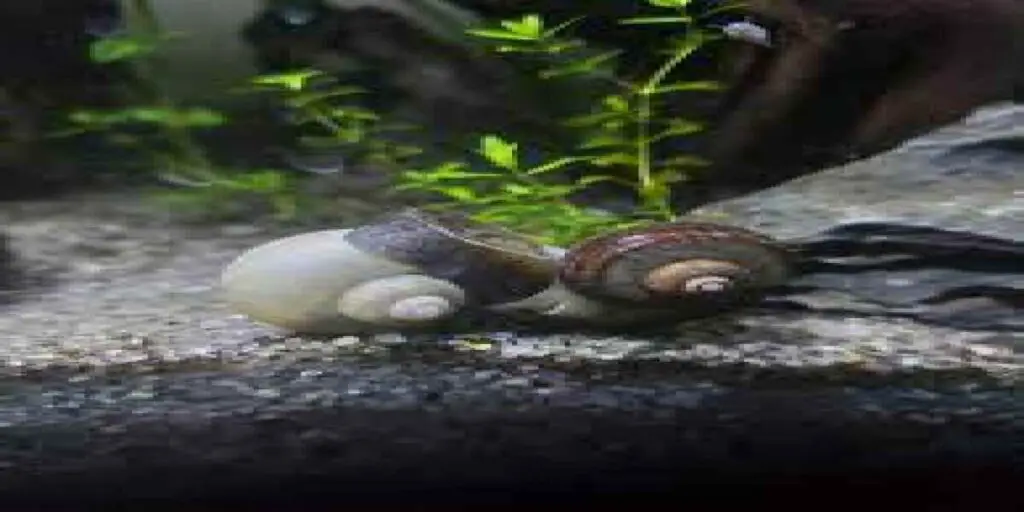
Mystery snails, also known as apple snails (Pomacea spp.), are popular freshwater snails in the aquarium hobby. With their vibrant colors and interesting behavior, they add a unique charm to any aquarium. However, observing certain interactions between mysterious snails can lead us to wonder if they are mating or engaging in aggressive behavior. In this article, we’ll explore the intricacies of the mystery snails mating or fighting, especially their mating rituals, and potential aggression.
Mating Behavior of Mystery Snails:
Courtship
Mysterious snails engage in elaborate courtship rituals before mating. During courtship, snails may exhibit interesting behaviors such as circling, crawling, and gently biting each other. This behavior is usually non-aggressive and serves as a means of communication and recognition between potential mates.
Mating and laying eggs:
Once a pair of mysterious snails have successfully hatched, they can hang from the surface of the water by connecting their bodies. This behavior, known as “hugging mating,” allows the snails to align their reproductive organs for successful egg fertilization. After mating, the female snail will deposit the eggs above the water line, usually on aquarium walls or other surfaces.
Egg clutches
Mysterious snail eggs are assembled into a gelatinous clutch, which provides protection and moisture to the developing embryo. Depending on temperature and other environmental factors, the eggs may take about two to four weeks to hatch.
Potential Aggression or Fighting:
- Competition for mates: Although mystery snails are generally peaceful, there may be instances of aggression, especially among males competing for female mates. Male snails may engage in pushing or head-butting to establish dominance and secure a chance to mate.
- Resource competition: Mystery snails can also show aggression if resources such as food, hiding places, or calcium-rich surfaces are limited. In such cases, snails may engage in territorial disputes or try to defend their preferred location.
- Shell Damage: Aggressive encounters between enigmatic snails can result in physical damage or shell damage. Scratches, chips, or missing pieces from snail shells can be signs of aggressive interactions.
Differentiating Mating from Aggression:
Duration and Intensity: Mating rituals are relatively short and less intense than aggressive bouts. Aggressive interactions can be longer and involve persistent pushing, biting, or chasing.
Mutual Behavior: During mating, both snails happily participate in courtship and mating hugs. On the other hand, in aggressive behavior, one snail shows dominant behavior while the other retreats or tries to escape.
Shell Damage: If physical damage or shell damage occurs, it is more likely to be aggression than mating behavior.
Do mystery snails fight each other?
Mystery snails are generally peaceful creatures and do not engage in frequent or intense combat. However, there may be occasional instances of aggression, especially when resources are limited or during mating rituals when males compete for female mates.
Male mystery snails may engage in pushing, head-butting, or chasing behavior to establish dominance or secure mating opportunities.
These aggressive interactions, although rare, are more likely to occur in confined spaces or in areas lacking food, hiding places, or surfaces suitable for egg deposition.
How do I know if my snails are fighting?
Determining whether mystery snails are fighting can be difficult because their interactions can be subtle. However, there are some signs to look out for:
Constant chasing: If you see one snail constantly chasing or chasing another, this may indicate aggression rather than mating behavior.
Physical damage: Aggressive encounters can result in visible damage to the shell, such as scratches, chips, or splinters. Check snail shells regularly for signs of injury.
Constant retreating: If a snail constantly retreats or tries to avoid another snail, this may be a sign of aggression.
Do mystery snails mate?
Yes, mysterious snails do mate. They have specific courtship rituals that precede mating. During courtship, snails engage in behaviors such as circling, groping, and lightly biting.
This interaction allows the snails to communicate and recognize each other as potential mates. After successful mating, male and female snails join their bodies in a process known as “mating throat” to align their reproductive organs for fertilization.
After mating, the female snail deposits her eggs above the water line, usually on aquarium walls or other surfaces.
How do you know if snails are mating?
Observing mystery snails mating can be an intriguing sight. Here are a few indications that snails may be in the process of mating:
- Circling Behavior: If you see two snails circling each other, this can be a sign of courtship and the early stages of mating.
- Entwined position: During mating, snails intertwine their bodies, often hanging from the surface of the water. This interlocked position facilitates the alignment of their reproductive organs for successful fertilization.
- Egg Deposit: After mating, the female snail lays eggs above the water line. Look for gelatinous clutches attached to aquarium walls or other surfaces.
Observing these behaviors indicates that the snails are likely in the process of mating. Providing suitable conditions, such as clean water, adequate nutrition, and suitable hiding places, can encourage successful reproduction in cryptic snails.
Also Read:
Conclusion
Mysterious snails engage in fascinating mating rituals and occasional territorial battles, revealing the fascinating dynamics of their social interactions.
